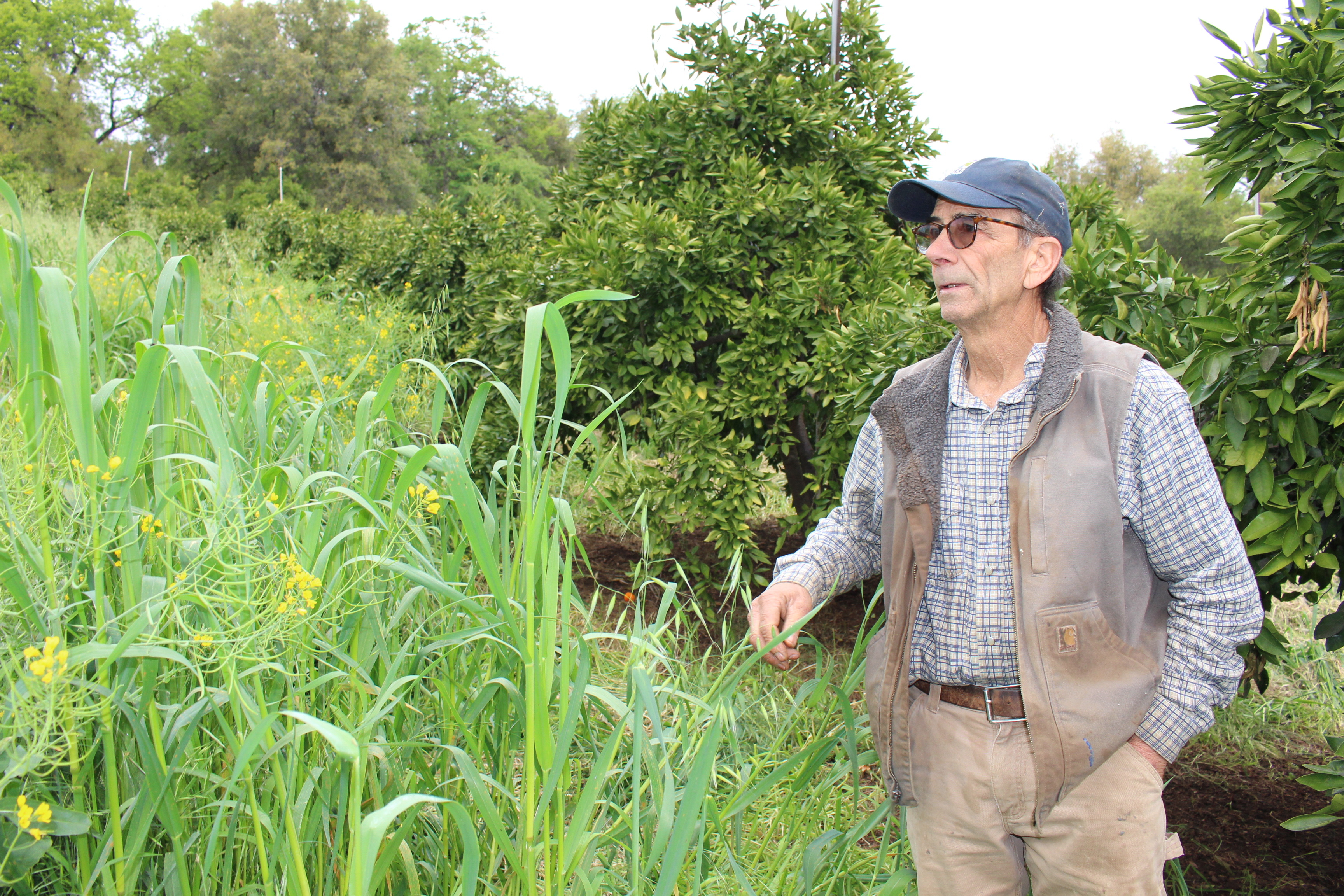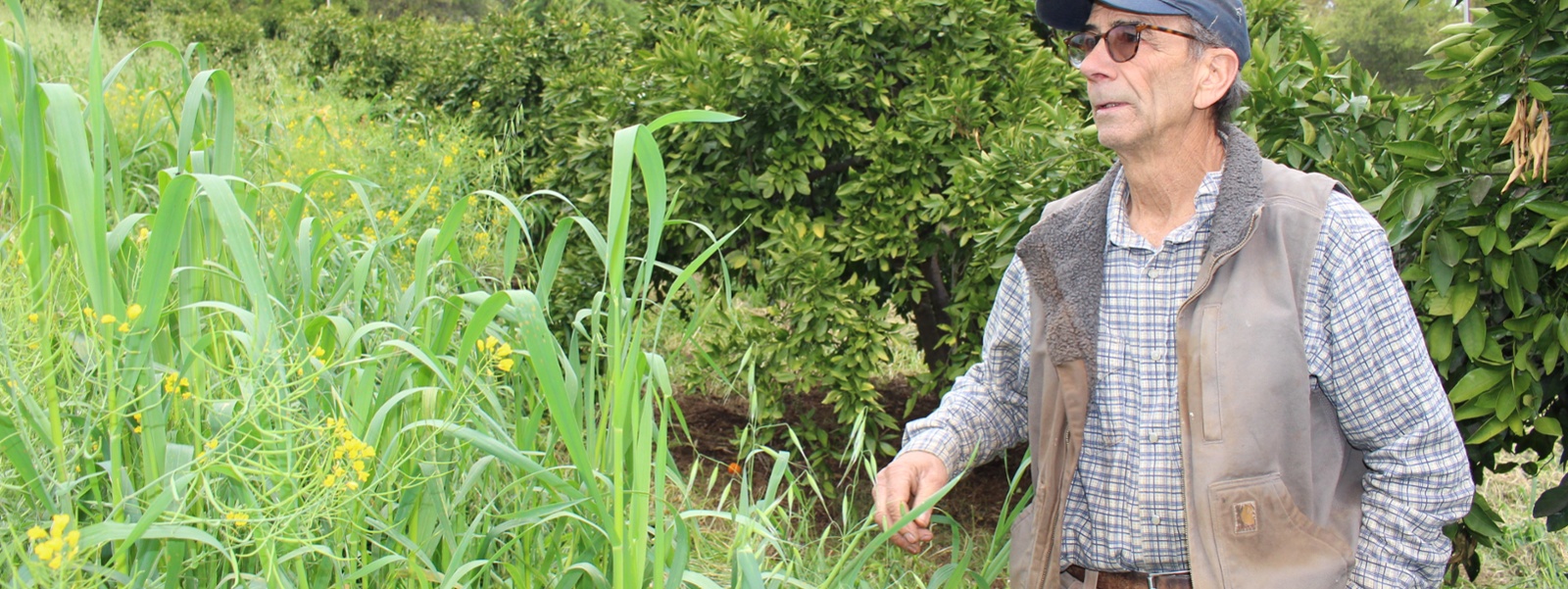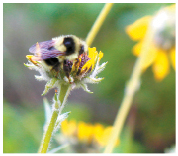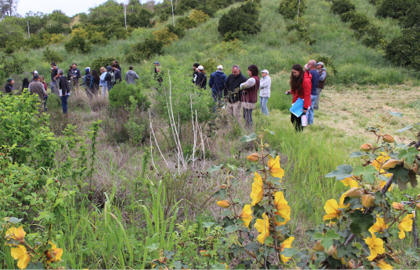Citrus farm showcases pollinator habitat

Placer County farmer Rich Ferreira walks through his organic citrus grove planted with a cover crop. He says conservation improvements he has made have benefited pollinators, soil health and the quality of his citrus crop.
Photo/Christine Souza


Photo/Christine Souza

Photo/Christine Souza
By Christine Souza
With honeybees and butterflies in decline worldwide, California farmers are doing their part to increase pollinator habitat, while also seeing on-farm benefits of reduced pest pressures and improved crop quality and soil health.
Placer County organic farmer Rich Ferreira, owner of Side Hill Citrus, said he has spent decades working on conservation projects. He has about 3 acres of native plants—some of them in blocks, some in hedgerows. He also has windbreaks.
“The government programs have helped me immensely over the years,” Ferreira said.
Ferreira’s Lincoln-based farm was the site of a pollinator habitat workshop by the Xerces Society and the Placer County Resource Conservation District last week. He led about 30 people on a tour to view decades of conservation work on his land.
Across from a citrus grove, he stopped to talk about a large hedgerow of native plants, which offer blooms for pollinators from early spring to fall.
Ferreira said he began work with the U.S. Department of Agriculture Natural Resources Conservation Service more than 20 years ago to create hedgerows and has since taken advantage of funding offered through government programs to add more plantings. He said the efforts attract pollinators and other wildlife to the land and benefit his certified-organic mandarin crop.
“Rich’s farm has many examples of pollinator habitat—hedgerows, cover crops and native plants—that support pollinators and other beneficial insects, improve soil health and sequester carbon,” said Margaret Honig, Healthy Soils Project administrative lead for the California Bountiful Foundation, a nonprofit science, research and education organization affiliated with the California Farm Bureau.
“What stands out at Side Hill Citrus is Rich’s care for the land. He is fostering a reciprocal relationship that benefits the ecosystem and his citrus farm,” Honig said.
Jessa Kay Cruz, senior pollinator conservation specialist for the Xerces Society, a nonprofit group dedicated to conserving invertebrate species, said habitat created by farmers offer pollen and nectar, and sites for nesting and overwintering.
“Loss of habitat is one of the biggest reasons (for declining pollinator populations), so planting hedgerows, flowering plants and a pollinator garden will bring a lot of these species and their populations back up again,” she said. “In our agricultural systems, about one in every three bites of food we consume require insect pollination, and that includes a lot of our most nutrient-rich foods, a lot of our fruits and vegetables and, indirectly, alfalfa.”
Increasing native plants, Cruz said, attracts beneficial insects that attack crop pests. This reduces pesticides, boosts soil health and prevents erosion, sequesters carbon and increases water infiltration.
“Insects like lady beetles, parasitic wasps or lacewings—natural enemies of crop pests—will hunt down a lot of your crop pests,” Cruz said. “They’ll go after aphids, scale and mealybug, so whatever your pest problem is, there is another insect out there that will eat that pest.”
When choosing where to plant native habitat, Cruz said, it is important to have an appropriate buffer between a crop that may be applied with pesticides and the habitat site. “The last thing you want to do is have all of these pollinators show up, and then the habitat gets contaminated,” she said.
“For a conventional grower using a ground rig and moderate pesticides, the buffer recommendation is 40 to 60 feet. If using neonicotinoids, which are problematic for pollinators because the contamination risk is much higher, you want to have a buffer of more than 100 feet,” Cruz said. “If you are spraying things that are not very harmful to insects with a backpack sprayer, which is more targeted, then the risk of drift is low, so you could have a buffer of 20 feet.”
To help determine buffer distance, Cruz suggested farmers visit https://ipm.ucanr.edu/bee-precaution-pesticide-ratings/ for bee precaution pesticide rating information by the University of California Integrated Pest Management program.
Other aspects to consider, she said, include ensuring there is plenty of sunlight, irrigation, soil quality, weed pressure and ease of management or accessibility.
“People tend to want to site the habitat in the ugliest, most degraded corner of their property because that’s usually what is available because everything else is planted to crops,” Cruz said.
When selecting what to plant, Cruz recommends a diversity of native plants that are adapted to the climate. She said transplants are easier to work with, but seeds may work better for a large planting.
“You want to have something blooming from the early spring to the fall because different pollinators have different life cycles,” Cruz said. “Think about plants for shelter, nesting and overwintering. Pithy-stemmed plants are great for our native pollinators, so things like elderberry and wild rose.”
As a resource for farmers looking for native plants, the Xerces Society contracts with nurseries to provide pesticide-free native plants that work for specific growing regions through its plant kit giveaway program.
“In our work with farmers, we learned the biggest barriers to planting habitat is funding and knowing what to plant,” Cruz said, adding the largest kit is for a 500-foot hedgerow. “This is a way to get plant material to the people who want to use it.”
Half of the 200 projects funded last year paid for habitat on working lands such as farms. The other half was for plantings on public lands such as schools and parks. Winegrape growers are the program’s No. 1 participant, Cruz said, followed by farmers of permanent crops such as nuts and fruits, and small farms.
Brian Pimentel, agriculture program manager for the Placer County Resource Conservation District, described funding opportunities for farmers interested in creating pollinator habitat. Programs through Placer RCD, he said, include the Central Sierra Healthy Soils Program. The deadline to apply is June 15.
The district also received funds through the Climate Resilience Through Restoration on California Lands Program. Funding to plant pollinator habitat is available through the state’s Health Soils Program and federally through the Environmental Quality Incentives Program, he said.
“If this is something that you are really interested in, there are financial resources out there to help you, plus education, such as workshops like this,” Pimentel said.
To learn more about funding and pollinator habitat programs, reach out to the Xerces Society at www.xerces.org or contact the local resource conservation district.
Through the Healthy Soils Program, citrus growers in 11 counties can receive up to $200,000 to offset costs of conservation practices, including planting native plants and hedgerows to increase pollinators and soil health, through a $5 million grant administered by the California Bountiful Foundation. To learn more, visit californiabountifulfoundation.com and click on the Healthy Soils Program link.
(Christine Souza is an assistant editor of Ag Alert. She may be contacted at csouza@cfbf.com.)




